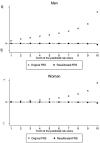A coronary heart disease prediction model: the Korean Heart Study
- PMID: 24848088
- PMCID: PMC4039825
- DOI: 10.1136/bmjopen-2014-005025
A coronary heart disease prediction model: the Korean Heart Study
Abstract
Objective: The objectives of this study were to develop a coronary heart disease (CHD) risk model among the Korean Heart Study (KHS) population and compare it with the Framingham CHD risk score.
Design: A prospective cohort study within a national insurance system.
Setting: 18 health promotion centres nationwide between 1996 and 2001 in Korea.
Participants: 268 315 Koreans between the ages of 30 and 74 years without CHD at baseline.
Outcome measure: Non-fatal or fatal CHD events between 1997 and 2011. During an 11.6-year median follow-up, 2596 CHD events (1903 non-fatal and 693 fatal) occurred in the cohort. The optimal CHD model was created by adding high-density lipoprotein (HDL)-cholesterol, low-density lipoprotein (LDL)-cholesterol and triglycerides to the basic CHD model, evaluating using the area under the receiver operating characteristic curve (ROC) and continuous net reclassification index (NRI).
Results: The optimal CHD models for men and women included HDL-cholesterol (NRI=0.284) and triglycerides (NRI=0.207) from the basic CHD model, respectively. The discrimination using the CHD model in the Korean cohort was high: the areas under ROC were 0.764 (95% CI 0.752 to 0.774) for men and 0.815 (95% CI 0.795 to 0.835) for women. The Framingham risk function predicted 3-6 times as many CHD events than observed. Recalibration of the Framingham function using the mean values of risk factors and mean CHD incidence rates of the KHS cohort substantially improved the performance of the Framingham functions in the KHS cohort.
Conclusions: The present study provides the first evidence that the Framingham risk function overestimates the risk of CHD in the Korean population where CHD incidence is low. The Korean CHD risk model is well-calculated alternations which can be used to predict an individual's risk of CHD and provides a useful guide to identify the groups at high risk for CHD among Koreans.
Keywords: Epidemiology.
Published by the BMJ Publishing Group Limited. For permission to use (where not already granted under a licence) please go to http://group.bmj.com/group/rights-licensing/permissions.
Figures
References
-
- World Health Organization. Cardiovascular diseases (CVDs) [Data file]. Retrieved from http://www.who.int/mediacentre/factsheets/fs317/en/index.html
-
- National Bureau of Statistics, Republic of Korea. Annual report on the cause of death statistics. Seoul, Republic of Korea, 2011
-
- Hense H, Schulte H, Lowel H, et al. Framingham risk function overestimates risk of coronary heart disease in men and women from Germany—results from the MONICA Augsburg and the PROCAM cohorts. Eur Heart J 2003;24:937–45 - PubMed
-
- Empana JP, Tafflet M, Escolano S, et al. Predicting CHD risk in France: a pooled analysis of the D.E.S.I.R., three city, PRIME, and SU.VI.MAX studies. Eur J Cardiol Prev Rehabil 2011;1:175–85 - PubMed
-
- Vergnaud AC, Bertrais S, Galan P, et al. Ten-year risk prediction in French men using the Framingham coronary score: results from the national SU.VI.MAX cohort. Prev Med 2008;47:61–5 - PubMed
Publication types
MeSH terms
LinkOut - more resources
Full Text Sources
Other Literature Sources
Medical
Molecular Biology Databases


